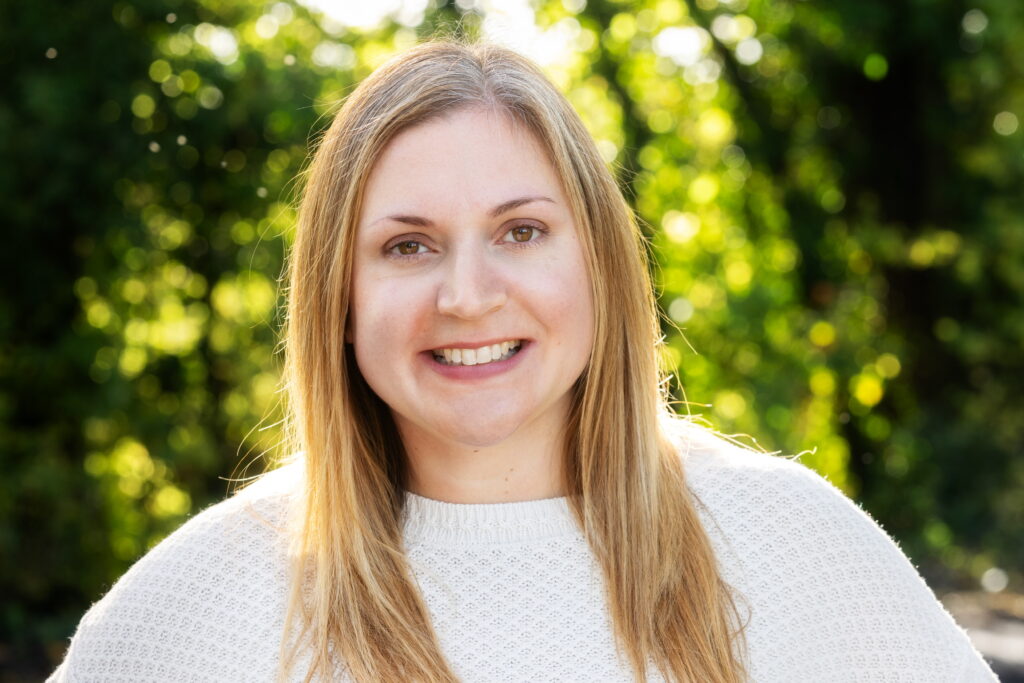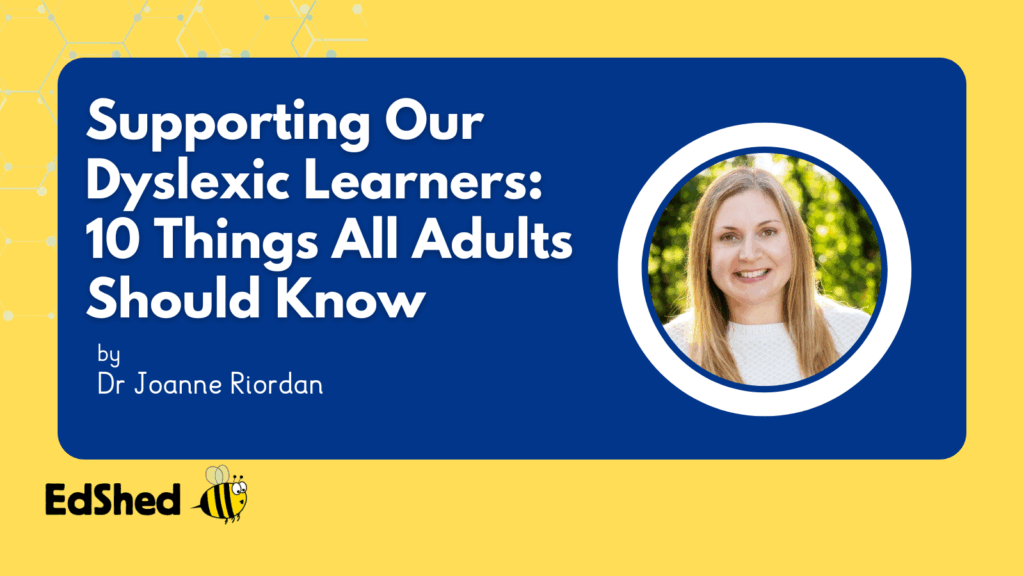Neurodivergent Educational Psychologist Dr Joanne Riordan shares her top tips for supporting learners with dyslexia.

Dyslexia is not a deficit — it’s a different way of thinking, learning, and experiencing the world.
As an Educational Psychologist, a neurodivergent person, and a parent to a dyslexic child, I see the full picture — from the classroom to the home, to the inner worlds of young people themselves. I’ve worked closely with hundreds of teachers through CPD training, and I regularly sit alongside children and families to explore what’s working — and what isn’t — when it comes to dyslexia support.
Through this work, I’ve heard directly from dyslexic learners about their strengths, their struggles, and the kinds of support that truly make a difference. I also understand, both personally and professionally, how overwhelming it can feel when school systems aren’t designed for the way your child — or you — learn best.
That’s why I’ve pulled together 10 key things I believe every parent, teacher, and advocate should know. Together, we can champion dyslexic learners and create environments where they thrive.
1) Diagnosis can feel like a minefield
First of all, it can be confusing to know who to approach for a dyslexia diagnosis. Even within the same profession, there are disparities in whether or not practitioners provide a diagnosis.
Some Educational Psychologists (like myself) do diagnose dyslexia, while others — whether working for a local authority or independently — choose not to. There are also specialist teachers who can assess and diagnose.
To complicate things further, the diagnostic criteria for dyslexia is quite narrow and doesn’t always capture the full picture. I follow the British Psychological Society’s definition, which says dyslexia is present when reading and/or spelling accuracy hasn’t developed, despite appropriate intervention over time. But ask any dyslexic person, and they’ll tell you: it’s about much more than reading and spelling alone.
2) Around 1 in 10 people are dyslexic
Dyslexia is common — so much so that there are likely dyslexic young people in every single classroom. That’s why it’s essential that all teaching staff continually update their understanding and practice. Reading articles like this and engaging in regular CPD is a great start — but the best way to enhance your practice is to listen to dyslexic young people themselves.
3) Dyslexia is associated with many strengths
Dyslexia isn’t just a difficulty — it’s a difference. And within that difference lie powerful strengths.
Richard Branson, who is himself dyslexic, worked with the charity ‘Made by Dyslexia’ to have ‘dyslexic thinking’ recognised as a valuable skill on LinkedIn. Dyslexic colleagues often bring creativity, innovation, and fresh perspectives to teams.
In a Tulip Financial Research study (commissioned for the BBC2 series ‘The Mind of a Millionaire’), 40% of 300 self-made millionaires had been diagnosed with dyslexia.
We need to ensure our dyslexic young people know their strengths — and that we nurture these strengths both inside and outside the classroom. That might mean setting a more creative task in a maths lesson or standing on the sidelines of a freezing football pitch to watch them score a goal. Either way, they need opportunities to shine.
4) Being dyslexic can be stressful — but not because of dyslexia itself
Dyslexia isn’t inherently stressful. But when a system isn’t designed with your needs in mind, that’s where the difficulties begin.
Our education system is still largely built around neurotypical learners — those who process information and experience the world in more typical ways. That’s why accommodations and adjustments are essential to make learning more inclusive for dyslexic students.
When these supports aren’t embedded, dyslexic learners can experience anxiety, frustration, and lower self-esteem. We need a holistic approach that supports emotional wellbeing as well as literacy.
One powerful, evidence-based method is co-regulation — where an adult helps a young person feel safe, connected, and calm through their own regulated, supportive presence. This is especially helpful during tasks that may feel overwhelming, like writing.
If you’re interested in learning more about co-regulation, I have a free guide available on my website: The Calming Guide to Managing Your Child’s Meltdowns — used by hundreds of schools and families across the UK.
5) Visual and multi-sensory methods really help
Between 80–90% of dyslexic learners experience challenges with phonological processing — the ability to hear, manipulate, and map sounds to letters. This means that approaches relying only on hearing information are often less effective.
Dyslexic learners usually benefit from multi-sensory learning — where they can see, hear, and physically interact with the content. That’s why Spelling Shed is so valuable: learners see the words, hear them, and interact with them through engaging games and activities.
6) Repetition is key — but it has to be engaging
Most dyslexic learners need lots of repetition to master reading and spelling skills. This is often linked to differences in procedural learning — how we learn to do something so well it becomes automatic.
But let’s be honest — repetition can be boring. Over time, young people may lose motivation if the learning feels stale.
This is where Spelling Shed comes into its own. It offers a variety of fun, engaging activities using the same word lists, helping learners stay motivated long enough to achieve real fluency.
7) All dyslexic individuals are unique
Knowing one dyslexic learner means…you know one dyslexic learner. I’ve worked with hundreds — and every single one has different strengths, needs, and interests. Even their reading and spelling profiles vary widely.
That’s why personalised support is essential. Tools like Spelling Shed work well because you can tailor the difficulty and adapt the activity to match a child’s interests. It’s also a great opportunity to give young people some choice and autonomy in how they learn — something that supports motivation and self-esteem.
8) Neurodiversity should be celebrated and normalised
I have helped many schools create a culture of understanding around neurodiversity — through CPD, assemblies, family workshops, and whole-school strategies. And it’s powerful.
We need communities where differences in learning, processing, and experiencing the world are not only understood but valued.
When neurodiversity is normalised, dyslexic young people feel accepted. Their peers are also more likely to understand and respect the accommodations they receive — because everyone recognises that different brains need different kinds of support.
9) Dyslexia is lifelong — and that’s okay
With the right support, dyslexic individuals can make great progress in reading and spelling. But dyslexia doesn’t “go away.” It’s a lifelong part of who someone is.
That’s why we must focus on building self-advocacy skills — the ability to recognise and communicate one’s own needs. We need to help young people understand their brains, their strengths, and what works for them. We also need to give them space to try different strategies, reflect on what’s helpful, and find their own voice in the process.
10) Families need support too
As a parent of a dyslexic child, I know firsthand how stressful and isolating it can feel. You’re constantly questioning whether you’re doing the right thing, advocating within a stretched system, and trying to nurture your child’s self-esteem along the way.
Families need professionals who truly understand their children’s needs — and who empower parents to be active partners in the support process.
We also need community — spaces where parents feel seen, supported, and understood. My own company was created to meet those needs. My Facebook page @DrJoanneRiodan has over 20,000 members — parents and educators looking for practical, neuro-affirming advice and support. I also run regular workshops and community spaces to connect families with each other and with me.
I’d love to welcome you there. We really are stronger together.
Final thoughts
I hope this article has left you feeling more empowered to support your dyslexic young person. Please don’t hesitate to get in touch via my website: https://www.drjoanne.co.uk if you’d like more information about:
- My CPD training opportunities for schools
- Neuro-affirming Educational Psychology assessments
- Resources to support your child
Warm wishes,
Dr Joanne Riordan
Educational Psychologist | Parent | Advocate

